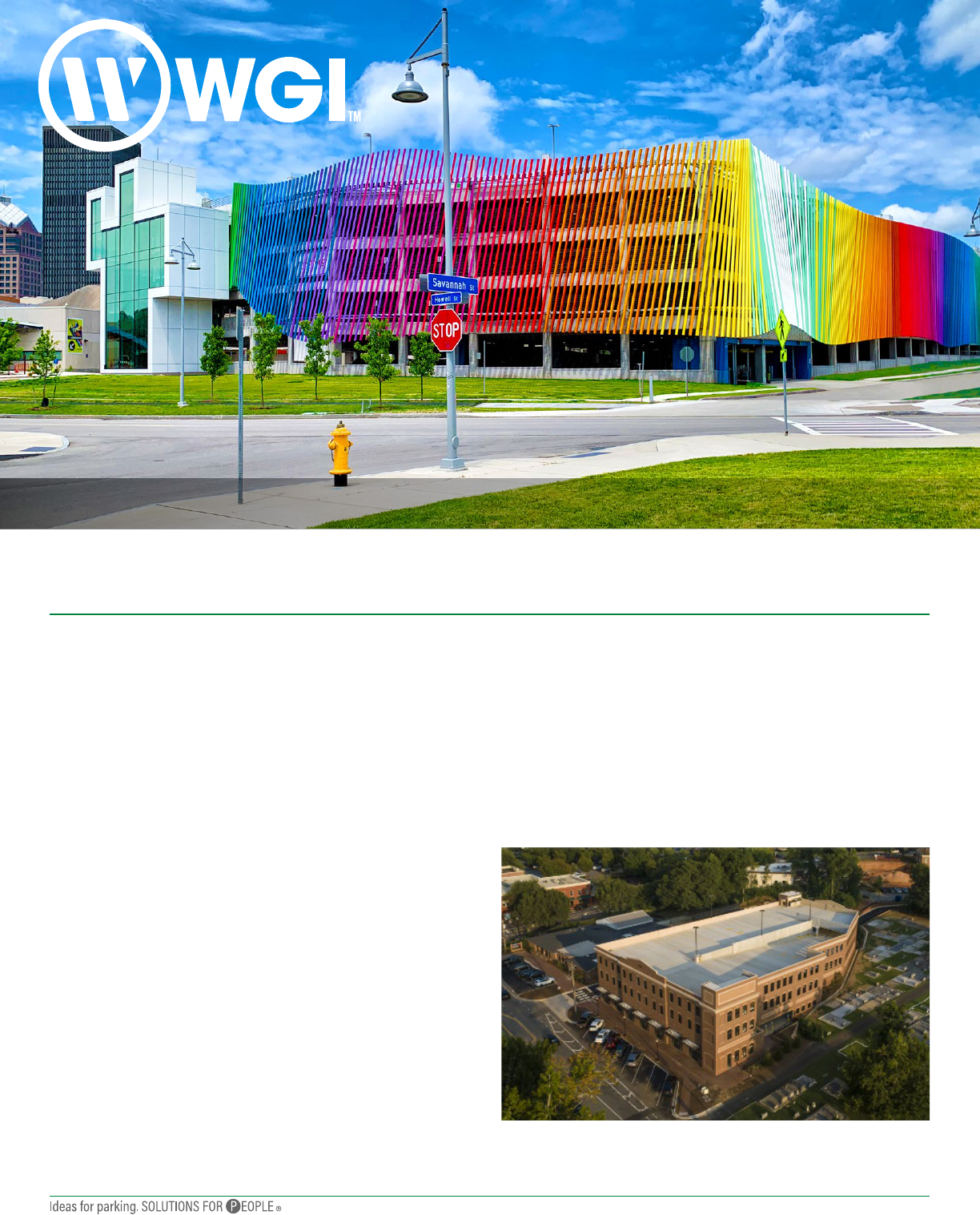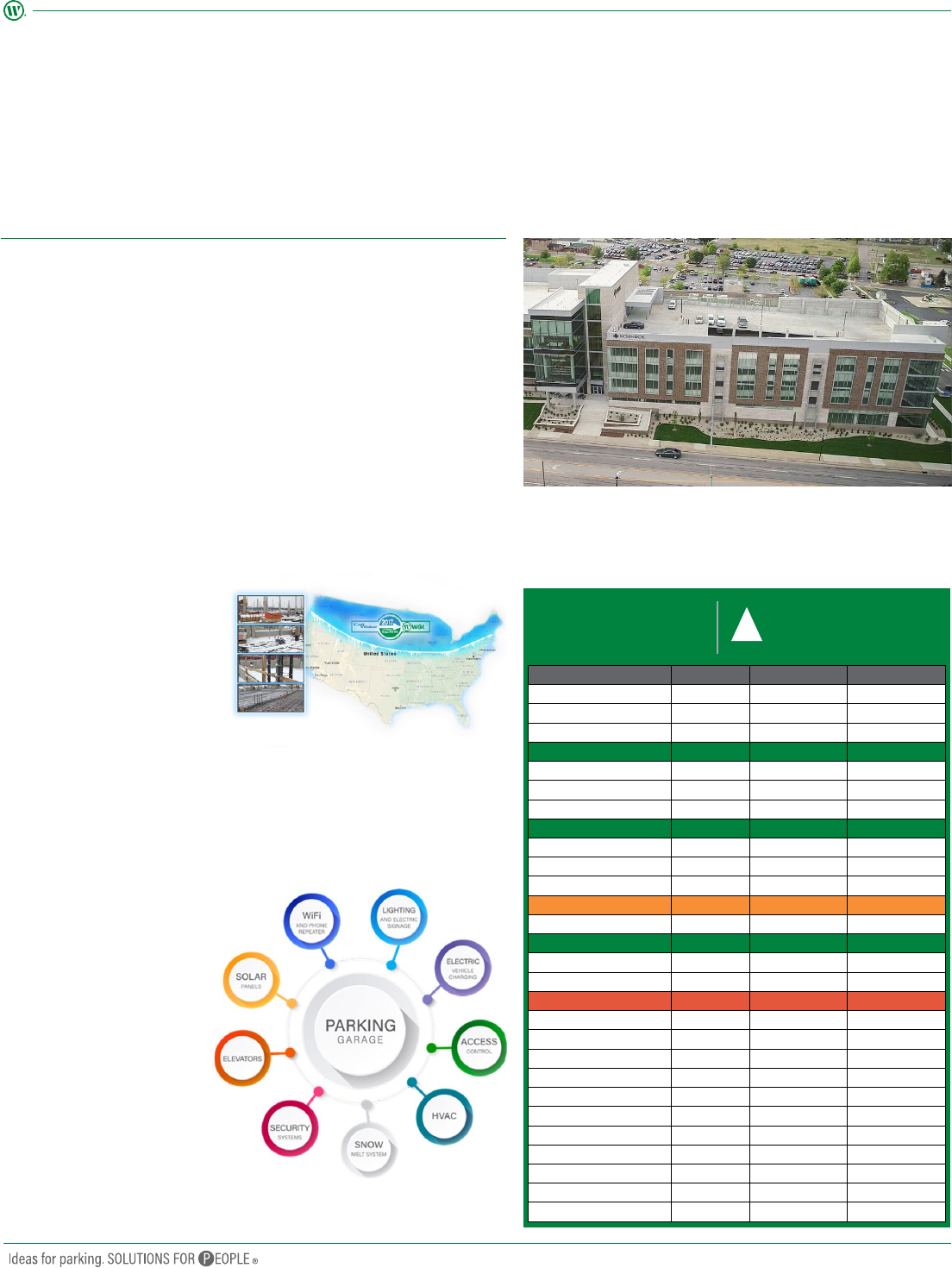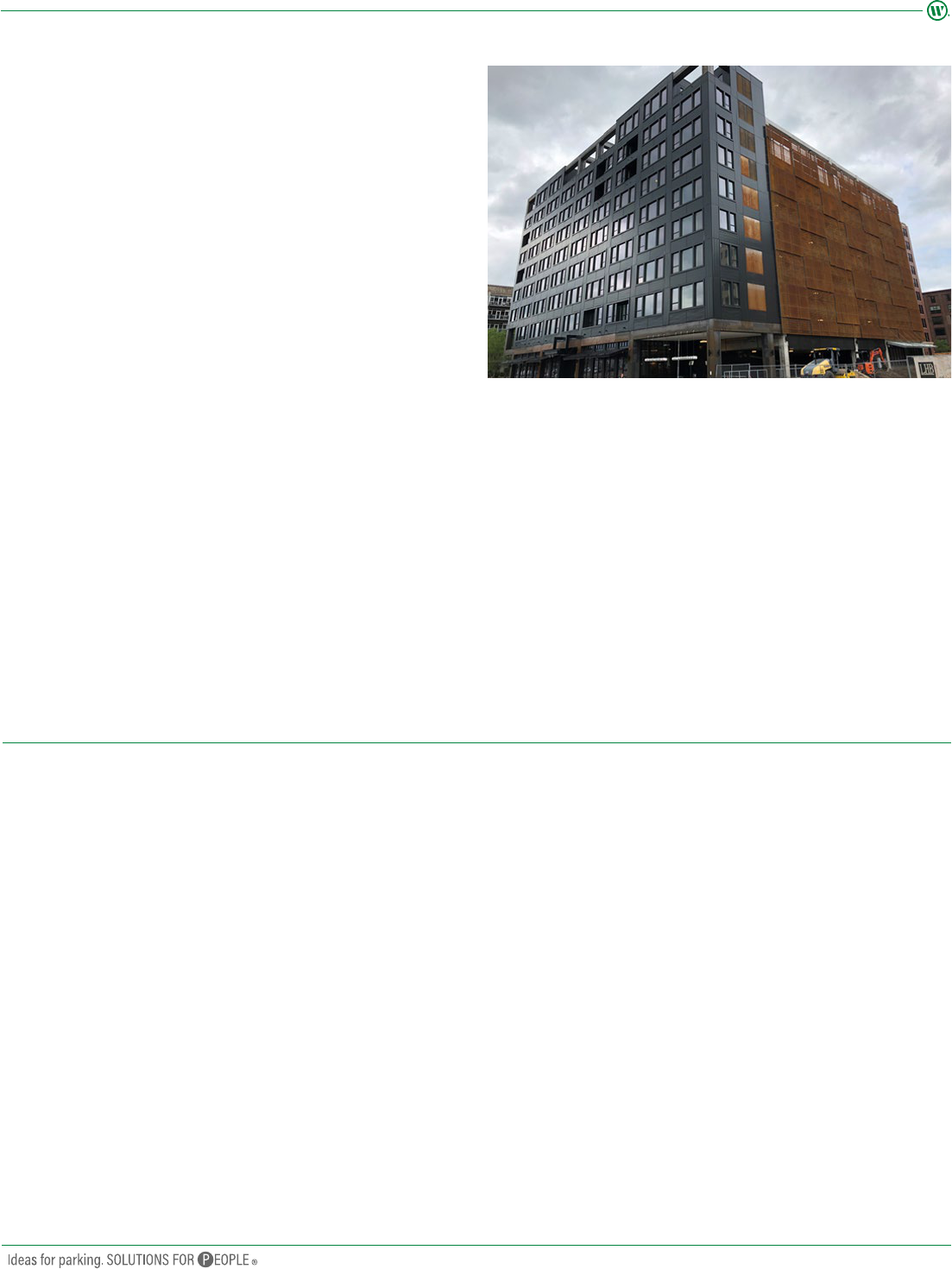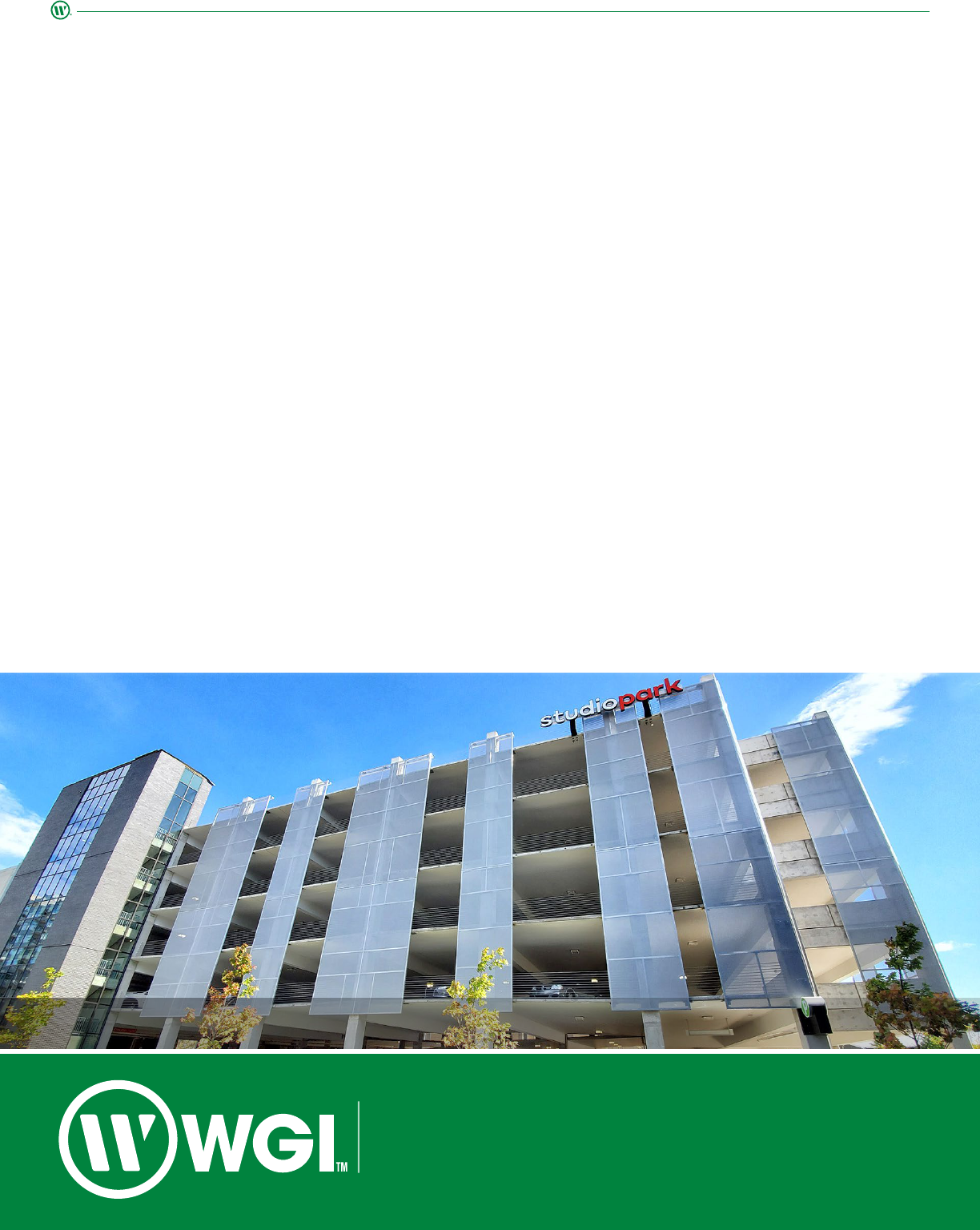
PARKING STRUCTURE COST OUTLOOK FOR
RAYMOND SMITH, PE, VICE PRESIDENT, WGI
WGI has specialized in parking structure planning and design since
1983, and our annual parking structure construction cost report
provides an important planning tool for owners, contractors, and
design teams.
WGI maintains a database of completed parking structure projects and
developed a methodology to analyze the historical cost information
to assist our clients and the industry. Our construction cost database
contains hundreds of completed parking structure projects of varying
size, scope, and geographic location. For this forecast, we only omit
the cost of parking structures that are completely or significantly
below grade, since their cost is much higher. The cost data is assigned
factors based on the time of bidding and location of the parking
structure. The time factor is based on the Building Cost Index (BCI),
published by Engineering News-Record (ENR). The location factor is
taken from the yearly edition of the RS Means Building Construction
Cost Data. Applying these two factors to actual construction cost data
adjusts the cost to a current national basis and from that we determine
the national median. The national median can then be re-adjusted to
reflect a median construction cost in almost every city in America.
As of May 25, 2020, our statistical data indicates that the median
construction cost for a new parking structure is $22,200 per space,
or $66.34 per square foot; a 3.3% increase from 2019 when the
median cost was $21,500 per space. The table below lists the 2020
median parking structure construction costs in various U.S. cities with
the lowest cost shared by Charlotte, Dallas, and Miami, the highest in
New York, and Kansas City, MO at the national median of 100.0.
It should be noted that the construction cost data does not include
costs for items such as land acquisition, architectural and engineering
fees, environmental evaluations, materials testing, special inspections,
geotechnical borings and recommendations, financing, owner
administrative and legal, or other project soft costs. Soft costs are
typically about 15% to 20% of construction costs, but can be higher
for owners who allocate their internal costs directly to the project.
Four-level parking structure constructed entirely of precast concrete with integrally
colored precast and face brick.
Oices Nationwide // 800.394.7275 // WGInc.com
THE STRONG MUSEUM OF PLAY PARKING STRUCTURE, ROCHESTER, NY

Oices Nationwide // 800.394.7275 // WGInc.com
FOR COMPARISON, A MEDIANCOST PARKING STRUCTURE TODAY TYPICALLY INCLUDES:
384-space parking structure with brick and stone façade that complements the
main building on the medical campus. The project is part of a multi-year, multi-
phase expansion which includes a five-story medical oice. Additional surgical
areas will also be developed with the main hospital to better serve patients.
City Index Cost/Space Cost/SF
Atlanta 88.0 $19,536 $58.38
Baltimore 94.0 $20,868 $62.36
Boston 116.0 $25,752 $76.95
Charlotte – Lowest 85.0 $18,870 $56.39
Chicago 119.0 $26,418 $78.94
Cleveland 96.0 $21,312 $63.68
Denver 91.0 $20,202 $60.37
Dallas – Lowest 85.0 $18,870 $56.39
Detroit 101.0 $22,422 $ 67. 00
Houston 87.0 $19,314 $5 7. 7 1
Indianapolis 92.0 $20,424 $61.03
Kansas City, MO – Median 100.0 $22,200 $66.34
Los Angeles 112.0 $24,864 $74.30
Miami – Lowest 85.0 $18,870 $56.39
Minneapolis 106.0 $23,532 $70.32
Nashville 87.0 $19,314 $5 7. 7 1
New York – Highest 132.0 $29,304 $87. 5 7
Philadelphia 11 7.0 $25,974 $7 7. 61
Phoenix 89.0 $19,758 $59.04
Pittsburgh 102.0 $22,644 $67.66
Portland 102.0 $22,644 $67.66
Richmond 88.0 $19,536 $58.38
St. Louis 101.0 $22,422 $ 67.00
San Diego 109.0 $24,198 $72.31
San Francisco 129.0 $28,638 $85.58
Seattle 109.0 $24,198 $72.31
Washington, D.C. 95.0 $21,090 $63.02
National Median 100 $22,200 $66.34
TODAY’S PARKING STRUCTURE CONSTRUCTION COST
WOULD BE HIGHER THAN THE MEDIAN IF IT INCLUDES THESE
ENHANCED FEATURES:
• 9’-0” wide parking spaces for improved user comfort
• Cast-in-place post-tensioned concrete superstructure for lower
maintenance costs
• Attractive façade with adorned precast, brick, metal panels, and
other materials
• Storm-water management including on-site retention / detention
• Deep foundations such as caissons or piling
• Below-grade construction
• Enclosed stair towers due to local code requirements
• Enclosed parking structure without natural ventilation where
mechanical ventilation and fire sprinklers are required
• Flexibility for future
parking / building
expansion, or
incorporation of roof-level
solar panels
• Service life in northern /
coastal regions beyond a
standard 50 to 60 years
• Grade-level commercial
space
• Mixed-use development where the parking is integrated with
oice, retail, residential, or other uses
• Custom wayfinding and signage system
• ParkSmart® Certification following the Green Business
Certification, Inc. (GBCI) program
• Energy eicient LED lighting
with occupancy and
photocell computer-
control system
• Enhanced parking
technology
– License plate
recognition
– Parking-guidance
system
– Car-count system with
variable-message LED
signs
– WiFi and cellular services
– Solar-energy collection
– Building Management System
• 8’-6” to 8’-9” wide parking spaces
• Precast concrete superstructure
• Precast concrete façade with a basic reveal pattern
• Glass-backed elevators and unenclosed stairs clad with
exterior glass curtain wall
• Standard wayfinding and signage
• Shallow-spread footing foundations
• All above-grade construction
• Open parking structure with natural ventilation; without
mechanical ventilation or fire sprinklers
• Minimal or no grade-level commercial space
• Standard parking access and revenue-control system
• Standard energy eicient LED lighting
Building Management Systems are
often used to help manage technology
2020 3.3%
CONSTRUCTION COST
FROM 2019

Oices Nationwide // 800.394.7275 // WGInc.com
FIRST QUARTER PREPANDEMIC
Heading into 2020 and prior to the Coronavirus (COVID) pandemic,
the key concerns were still labor shortages in construction trades,
taris, and trade relationships. The construction market showed
signs of slowing down, but growth was expected to continue into
2020. Likewise, construction of mixed-use and stand-alone parking
structures was to remain steady. Prior to the COVID pandemic industry
experts reported the following regarding construction activity:
• The American Institute of Architects (AIA) chief economist Kermit
Baker, PhD stated that, “design activity at architecture firms,
historically a very accurate leading indicator of future construction
activity, showed unexpected weakness earlier in 2019. However,
design billings improved during the fourth quarter, and new projects
coming into architecture firms saw strong growth toward the end
of the year. So, while 2020 and 2021 are expected to see only very
modest gains in construction spending nationally, the prospects of
a more significant downturn over this period have dimmed recently.”
The article also reported that, “The American Institute of Architect’s
Consensus Construction Forecast Panel is projecting just a 1.5%
increase in spending on nonresidential buildings this year and less
than 1% increase in 2021, according to recently released results.”¹
• Turner Construction’s Turner Building Cost Index, which tracks
construction costs, indicated 1.29% increase in the fourth quarter
of 2019 and a 4.84% increase during 2019. Its 2019 Fourth Quarter
Forecast states that, “We continue to see the construction market
fairly busy with several large projects starting in the fourth quarter
of 2019.”²
• ENR reported in its 2019 Fourth Quarter Cost Report a forecasted
1.6% increase in the Building Cost Index for 2020.³
• ENR reported in its 2020 First Quarter Cost Report that, “The concern
about the emergence of COVID-19, as the disease caused by the virus
is known, has had surprisingly little impact on industry executives’
views of the construction market in the near term, at least as seen in
the latest results of ENR’s latest Construction Industry Confidence
Index (CICI) survey. It rose four points to 56 in the first quarter of
2020 from the fourth quarter of 2019 – an especially surprising result
given that 44% of the surveys came in after the media began heavy
coverage of the health crisis.”⁴
PARKING INDUSTRY CONSTRUCTION ECONOMIC FORECAST
Eight-level, 400-space CIP PT parking structure. The development includes street-level
retail, a nine-story residential building, and a 10-story oice building.
SECOND QUARTER PANDEMIC
During the pandemic shutdown, the AIA Architecture Billings Index
(ABI) score plummeted to 29.5 in April, a new all-time low. Any
number below 50 indicates a decrease in billing. The ABI serves as
a leading economic indicator that leads non-residential construction
activity by approximately 9-12 months. The northeast region was hit
the hardest followed by the south region. Firms in the west region
reported somewhat less dramatic losses than the other regions in
April, but overall, all the regions had significant declines in billings.⁵
This decrease in billings resulted in approximately 11,000 positions, or
approximately 5.5%, lost in architectural firms in April. The construction
industry also lost 995,000 jobs in April, 13% of the workforce.
The AIA published an April 6 update to its 2020 projections for the non-
residential construction industry. The article stated, “The American
Institute of Architect’s Consensus Construction forecast panel is now
projecting an 11% decline, with the sharpest decline predicted to occur
in the commercial construction sector. While a slight 0.6% growth was
originally forecast for 2020, it has now been revised down to a loss of
14%. Institutional construction spending will also be hard hit, although
not quite as seriously as commercial with losses of 7% now projected
versus 2.9% growth predicted in December.”⁶
An article published by For Construction Pros on April 10, 2020,
noted, “Dodge forecasts the square footage of parking garage starts
this year falling 29%, oice starts dropping 13%, retail space down
33%, and hotels and motels down 31%. The biggest commercial
building sector — warehouses — however, is only expected to slip
1%.”⁷
As the world tries to recover from this global pandemic and the
economy here in the United States starts to open up, there remains
uncertainty in the design and construction industry. AIA Chief
Economist Kermit Baker, PhD noted, “A large portion of the design
and construction industry remains mired in steep cutbacks as many
businesses and organizations are still trying to figure out what actions
make sense in this uncertain economic environment.” He went on
to add, “There are growing signs of activity beginning to pick up in
some areas, but others are seeing a pause as pandemic concerns
continue to grow.”⁸
However, there are some positive signs out there. The housing
sector seems to be quickly recovering. The AIA Architecture Billings
Index (ABI), which plummeted to 29.5 in April, rose to 32.0 in May.
Construction employment in May increased by 464,000 jobs.

TOMORROW’S INFRASTRUCTURE SOLUTIONS, TODAY
Oices Nationwide // 800.394.7275 // WGInc.com
SUMMARY
What does all this mean for the construction of new parking structures
and the median construction cost for these facilities in 2020? Before the
COVID pandemic hit, the American Institute of Architect’s Consensus
Construction Forecast Panel was projecting just a 1.5% increase in
spending on non-residential buildings and the Engineering News-Record
forecasts a 1.6% increase in the Building Cost Index. As the economy
starts to reopen, there is just too much ambiguity and not enough data
yet to fully understand the complete impacts of the pandemic, but
early indications point to a significant decline in the institutional (14%
loss) and commercial (7% loss) sectors that traditionally build parking
structures. With the potential reduction in material costs, the reduced
labor shortages, and increased competition, parking structure costs in
2020 may actually decrease in some regions.
The parking professionals at WGI are happy to assist with the budgeting
of your next parking structure. If you have any questions or would like
specific cost information for your area, contact Raymond Smith at
[email protected] or call us at 800.FYI.PARK (800.394.7275).
WGI is an ENR Top 500 engineering and consulting firm specializing
in Land Development and Municipal Engineering, Traic and
Transportation Engineering, Parking Solutions, Geospatial Services,
Subsurface Utility Engineering, Structural Engineering, Landscape
Architecture, Environmental Sciences, Architecture, Land Planning,
MEP Engineering, New Mobility Services, and Water Resources. The
WGI Parking Solutions group specializes in parking structure design;
structural engineering; parking studies; parking operations consulting;
and restoration of parking structures, plazas, facades, and other
buildings just as Carl Walker did for 33 years.
REFERENCES
1. “A marked slowdown, but no projected decline for
nonresidential building”, by Kermit Baker, Hon. AIA, PhD. The
American Institute of Architects, from AIA website: https://
www.aia.org/articles/6260039-a-marked-slowdown-but-no-
projected-decline.
2. Turner Construction Company. “Turner Building Cost Index –
2019 Fourth Quarter Forecast,” Turner Construction Company
website: http://www.turnerconstruction.com/cost-index.
3. “Analysts See Oil and Steel Price Drops as Growth Slows”,
by Alisa Zevin, Engineering News Record, December 23/30,
2019.
4. “Will the Coronavirus Stunt Construction’s Rising Market”, by
Gary J. Tulzcz, Engineering News Record. March 16/23, 2020.
5. “ABI April 2020: Business conditions at architecture firms
weaken even further” The American Institute of Architects,
from AIA website: https://www.aia.org/pages/6296537-abi-
april-2020-business-conditions-at-arch.
6. “An update on 2020 projections for the nonresidential
construction industry”, The American Institute of Architects,
from AIA website: http://www.aia.org/pages/6287230-an-
update-on-2020-projections-for-the-nonr.
7. “Dodge Reforecast: COVID-19 Impact on 2020 Construction
Starts”, For Construction Pros Website: https://www.
forconstructionpros.com/business/news/21128029/dodge-
data-analytics-dodge-reforecast-covid19-impacts-on-2020-
construction-starts.
8. “Architecture billings downward trajectory moderates”, The
American Institute of Architects, from AIA website: https://
www.aia.org/press-release/6306192-architecture-billings-
downward-trajectory-.
STUDIO PARK MIXED-USE DEVELOPMENT, GRAND RAPIDS, MI
